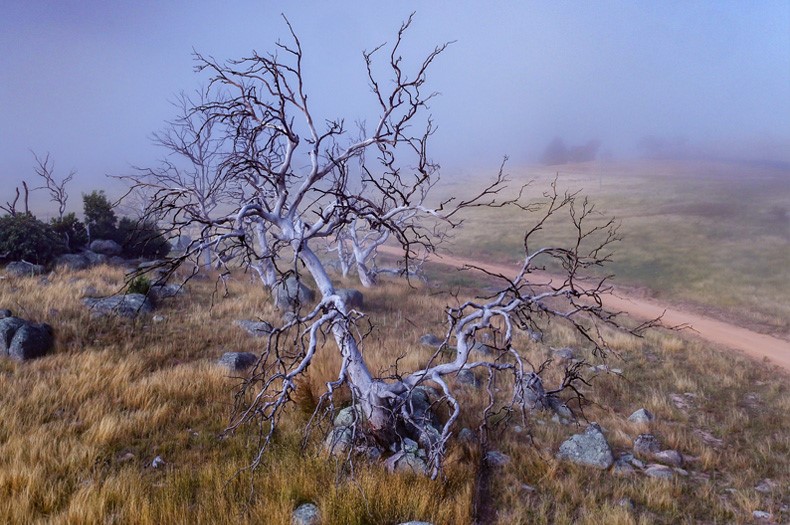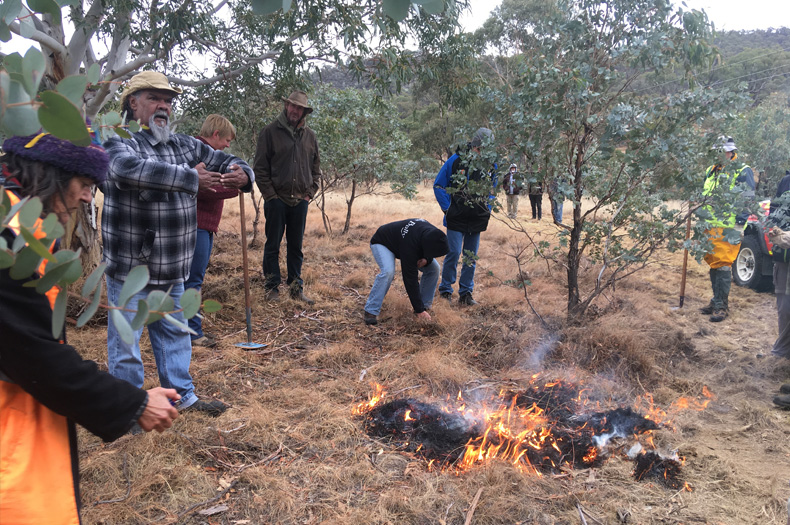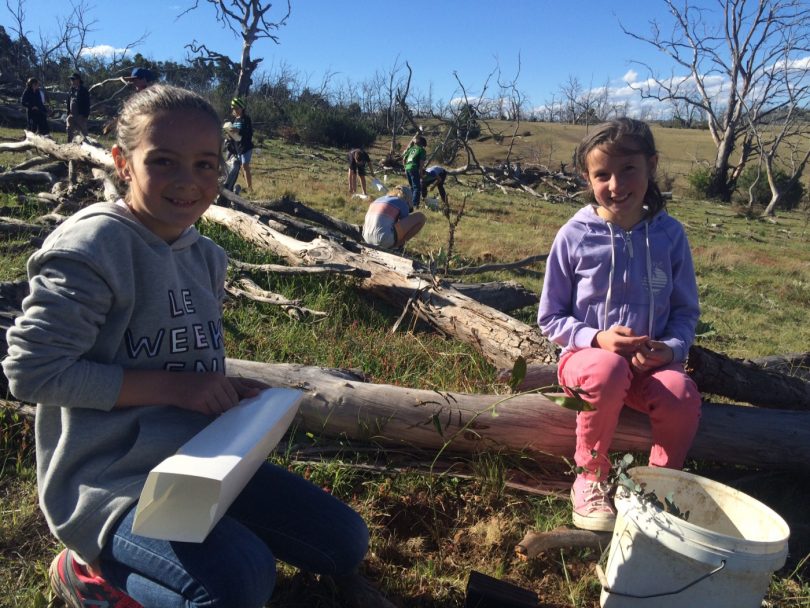
Concerns the population of ribbon gum, or manna gums, on the Monaro are edging to the brink of extinction is resulting in a swathe of action to restore the health of the landscape. Photo: Greening Australia.
It was once termed a tree graveyard and certainly the 27-minute drive between Cooma and Berridale carries a silence that could be mistaken for a requiem.
In this place on the Monaro – at the eastern edges of the heavily forested Snowy Mountains – lie remnants of once-wooded bushland which by civilisation and habitation, by axe, by saw, by hand and by weevil has gradually slipped away.
From above, it’s like a bad shave: tracts of bare land bearing scars with scattered remains of native ribbon gums – also known as manna gums or Eucalyptus viminalis – trailing out to bristles.
However, on Saturday, 14 November, the landscape will be covered with people, gloved growers of greenness, intent on raising a forest from the dead and restoring life to the land.
The half-day community tree planting event is being organised by Greening Australia, CSIRO, Upper Snowy Landcare Network and South East Local Land Services, who have all long had this landscape and its mysterious decline – or dieback – in their sights.
The event forms part of an overarching, long-term research and restorative program called the Monaro Comeback program.

Traditional burns have been implemented to provide seedlings with a healthier growing environment. Photo: Greening Australia.
Those involved are urging everyone to pitch in to help pull the species of tree back from annihilation and hopefully provide a working model for other restoration work throughout the nation.
Dieback isn’t breaking news. First detected in the NSW New England region in the 1970s, it has long been a battlefront in farmlands where two centuries of land clearing, increasingly enhanced and chemically dependent agricultural practices, bushfires, prolonged drought, pollution and increased salinity levels have all wrestled with indigenous species for their square inch of Australia.
The stress on the determined few has left them vulnerable to attack from a range of quarters, among them rising groundwater, fungal disease or repeated defoliation by insects.
First clocked three decades ago, the decline of the species in the Monaro has been attributed largely to the native eucalyptus weevil, a tiny beetle which targets stressed gums in large numbers, feasting on their leaves, depriving the trees of their canopy and their ability to produce energy from the sun.
Around 2000 square kilometres have already been impacted in a short period of time and there are fears the trees are on the brink of extinction.
Ecologist Dr Catherine Ross has made a study of it. She says dieback in rural landscapes is often linked to agricultural practices and land degradation, but in this part of the Monaro both rural lands and reserves are equally affected, suggesting the cause may be on a much larger scale.
“In our study, ribbon gums appeared to be uniformly dead or showing signs of severe dieback regardless of their local environment,” said Dr Ross. “Areas that had been fenced off or with no other major disturbance might have been expected to be more resilient to dieback, but they were as badly affected as those in paddocks that had been fertilised or grazed.”

Monaro school children have been part of the solution to restoring the landscape, taking part in workshops held on the Monaro. Photo: Greening Australia.
Greening Australia project manager Nicki Taws said the loss of the trees has had a devastating effect on local landholders, the landscape and wildlife.
Several species of threatened woodland birds are particularly at risk including the diamond firetail, scarlet robin, hooded robin and brown treecreeper.
“The Monaro is a stronghold for these woodland birds that are becoming harder and harder to find in areas to the north,” said Ms Taws. “It’s a last post for many of these species and the disappearance of the ribbon gums completely from the landscape would mean the disappearance of these birds, too.”
Ms Taws said long-term resident landholders are watching the trees they have grown up with simply dying and not being replaced.
“It impacts them directly in terms of the survival of their stock and productivity,” she said. “You only have to be in the Monaro in the depth of winter to know what a big effect the loss of tree cover has had on reducing shelter and shade, and increasing erosion and weed cover.”
Along with landholders and Indigenous groups, the long-term plan involves trialling various native species – including ribbon gums from other areas – and planting patches of diverse habitat to relink private properties.
Traditional burns have been implemented to provide seedlings with a healthier growing environment.
Local landholder Charles Massy said that by keeping groundcover and encouraging natural regrowth of vegetation around the trees, plus planting, “we are hopeful we can halt this creeping form of land cancer and restore our land”.
The community planting for Monaro dieback is supported by the NSW Environmental Trust and Officeworks. The event is being held on Saturday, 14 November at Bobundara, 43km south of Cooma.
The morning of planting trees will be followed by a barbecue lunch. No prior experience is needed, but volunteers should come prepared with enclosed footwear, gloves, a water bottle and sunscreen. Tools will be provided.
RSVP is essential by 5 pm on Wednesday, 11 November by contacting Nicki Taws on 0408 210 736.
Original Article published by Edwina Mason on About Regional.












